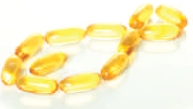The market for fish and other marine oils is a nutrition industry behemoth. It has even surpassed multivitamins in terms of the percentage of consumers that use them, at 72% for fish/marine oils to 65% for multivitamins, according to one survey from early 2013 (1). However, that same survey did not place marine oils among the fastest growing segments of the supplements market. This indicates a saturation point has been reached, or at least is rapidly approaching.
But, it has taken an ocean full of research and hard work by industry stakeholders to get this market saturated. It certainly figures to remain at this successful juncture, mostly because consumer awareness of the health benefits of fish oil is very widespread.
Despite most everybody being on board, it’s important to keep up with the ever-evolving product trends and science in this category to better serve customers. “Omega-3s are such a critical building block to health, and ongoing research continues to be extensive. It is inevitable that our knowledge will continue to expand with regard to their mechanisms of action and the scope of their impact on optimizing health,” says Keri Marshall, M.S., N.D., chief medical officer at Nordic Naturals, Watsonville, CA. Read on for the latest on that very research, as well as issues like taste masking, delivery formats and introducing kids to marine oils.
Trends in Formulation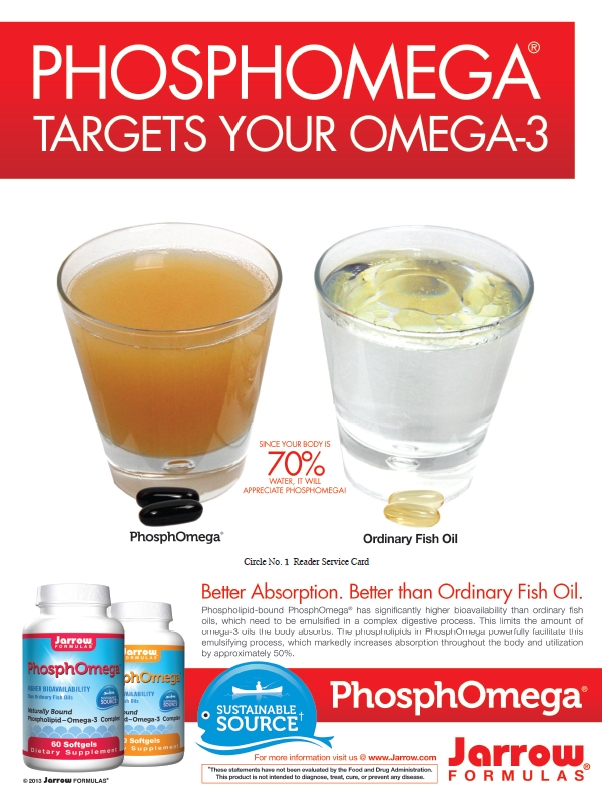
Both to edge out the competition and to meet consumer preferences, suppliers and manufacturers in the marine oil market continue to innovate and reconfigure their offerings, as well as adjust the way those offerings are marketed. There are a few general trends to note, including some “must-haves” that marine oil consumers have come to expect in a product.
One shift to track is the introduction of more diverse and targeted marine oil product lines. “Originally, the focus was on the well-being market where consumers were told that taking omega-3 oils on a regular basis would reduce the risk of developing diseases related to aging and bad dietary habits, such as arthritis, cardiovascular diseases, etc.,” says Baldur Hjaltason, sales director for Epax AS, Oslo, Norway. More recently, he says, some consumers are turning to condition-specific formulas that feature concentrated EPA and DHA doses in different ratios meant to target specific health issues, like eye or brain health.
There is also a movement toward fulfilling the consumer demand for minimal processing and refinement, according to Inbal Eyal, clinical research and regulatory affairs manager for the BioActive Ingredients division at Enzymotec, Migdal HaEmeq, Israel, and Hilla Attias, marketing manager for that division. This “whole food” approach may provide some extra nutritional value, as we’ll hear later.
For marine oils in general, Hjaltason says, recent production technology has allowed for better nutrient yields. This has allowed higher concentrations of omega-3s to become available at more affordable prices for consumers. Today, almost any concentration and ratio of EPA and DHA is available, so Hjaltason believes the market will need to find different ways of differentiating products for consumers.
Todd Parker, vice president of Marine Ingredients, Mt. Bethel, PA, observes that most companies are interested in higher concentrates, with over 70% omega-3 content a common target. Though this helps reduce the size of what must be swallowed, the problem is that formulas with such high concentrations are more expensive per gram of omega-3 than one concentrated at 50%, he says for example. “We will see if the end consumer is willing to pay twice as much per gram of omega-3 for a smaller soft gel,” Parker says.
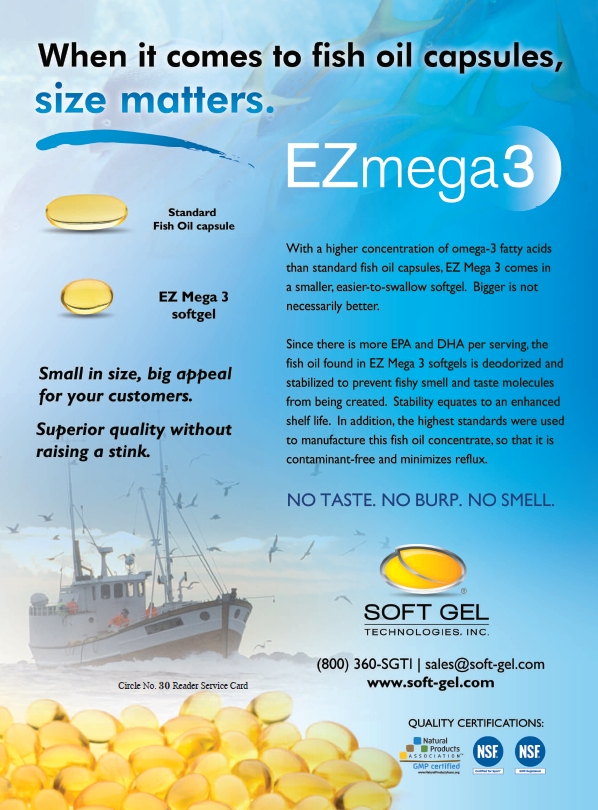 The debate continues, according to Hjaltason, about which forms of marine oils are best (ethyl esters versus triglycerides versus free fatty acids and others). This debate will continue to involve both manufacturers and consumers, he believes, because there are considerable price differences involved, making purchase decisions difficult for consumers.
The debate continues, according to Hjaltason, about which forms of marine oils are best (ethyl esters versus triglycerides versus free fatty acids and others). This debate will continue to involve both manufacturers and consumers, he believes, because there are considerable price differences involved, making purchase decisions difficult for consumers.
The purity of marine oil products is still of great importance, Hjaltason adds, and there continues to be a focus on making oils from sustainable wildlife stocks. There will likely be more demand in the future for third-party sustainability certification, he says, as well as country of origin verification.
Consumer expectations for their omega-3 products underlie most of the considerations just discussed. Just because marine oil supplements have become a ubiquitous commodity item, don’t assume that consumers don’t want more from them, says Cheryl Myers, chief of education and scientific affairs at EuroPharma, Inc., Green Bay, WI. “You have to provide something above and beyond the typical spoonfuls of oil or handfuls of capsules,” she says.
These distinguishing factors can include tasting like something aside from fish (including natural fruit flavors), or a high level of convenience to make compliance with suggested uses easier for consumers, Myers says. She believes products must stand on their own merits, not just the reputation of omega-3s and marine oils as a category.
Taste and taste masking. The presence of sometimes unpleasant fishy taste, smell and digestive issues didn’t stop the marine oils market from expanding over the years. But now, many consumers have loftier expectations for their marine oil experience that manufacturers seek to meet.
Becky Wright, communications and marketing manager for Aker BioMarine, Issaquah, WA, says that research has shown a large percentage of consumers who take omega-3s prefer products other than traditional fish oils, due to large pills (a dosing/concentration level issue) and the potential for digestive reflux. This may be due in part to perception issues some consumers have with fish oil. These views may not match up with today’s reality, but they impact the market nonetheless.
Some of nature’s healthiest foods aren’t  necessarily the best tasting, and fish oil fits that bill, says Andreas Koch, marketing director for Barlean’s, Ferndale, WA. He says that the unflavored cod liver oil taken straight off the spoon of yester-year has thankfully been replaced by a wide selection of flavored fish oils.
necessarily the best tasting, and fish oil fits that bill, says Andreas Koch, marketing director for Barlean’s, Ferndale, WA. He says that the unflavored cod liver oil taken straight off the spoon of yester-year has thankfully been replaced by a wide selection of flavored fish oils.
Taste and smell remain the primary criteria for consumer consumption and compliance, says Wael Massrieh, Ph.D., vice president of scientific affairs at Neptune Technologies & Bioressources, Laval, QC, Canada. “Interestingly, certain countries such as in Asia and more natural/organic channels of distribution are more accepting of off-taste and smell due to a belief that the product is in its more natural and thus more effective format,” Massrieh says.
Especially when it comes to liquid omega-3s, Parker believes, consumers expecting a bad taste are usually surprised to find products that are very neutral in taste and smell. The refining techniques used by today’s top manufacturers, Parker says, remove almost all sources of strong taste and smell, and natural flavors are often added to oils to create good-tasting supplements. He thinks that liquid omega-3s are strongly positioned to gain market share, once consumers discover they offer a competitive price point and easy dosing.
It is important to understand that a neutral taste and smell, and preventing the rancidity that can lead to reflux, should be expected when marine oils are properly produced and handled, according to Hjaltason. So, added flavors can be looked at as masking taste and smell, as well as enhancers to a more neutral taste in high-quality products. As long as the oil is not highly concentrated, it is relatively easy to produce a product without offensive qualities, he says.
Oils become stressed through the concentration process, and the more concentration being performed, the more stress occurs. This stress leads to oxidation if production isn’t executed well, Hjaltason says. The volatile compounds formed during oxidation make for a bad taste and smell. Although antioxidants are available to help protect against this oxidation, this usually doesn’t protect the oil well enough when it is stored for long periods of time. Marshall summarizes by saying, “Oxygen-free manufacturing of omega-3s is critically important to freshness and biological efficacy.”
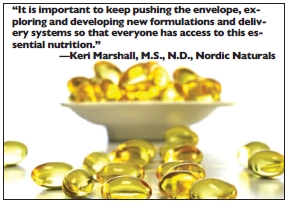 Soft gel formats have been the best way to protect against oxidation, Hjaltason says, adding, “However, improved processing technology and better microencapsulation technology will offer new possibilities to use highly concentrated fish oil in functional food in the near future.”
Soft gel formats have been the best way to protect against oxidation, Hjaltason says, adding, “However, improved processing technology and better microencapsulation technology will offer new possibilities to use highly concentrated fish oil in functional food in the near future.”
One unique, proprietary process called multi-stage oil extraction (MSO) prepares the oil such that freshness is ensured, according to Eyal and Attias. This is due to the removal of spoilage indicators including trimethylamine (TMA) and total volatile basic nitrogen (TVN). “TMA and TVN are the most common chemical parameters for assessing the freshness of marine products,” they say.
Catering to kids. Parents often have trouble getting their kids to eat anything, let alone consistently take a supplement that may not be the most appealing in terms of taste and smell. Having oils that aren’t fishy tasting is quite helpful in this regard, says Jolie Root, nutritionist at Carlson Laboratories, Arlington Heights, IL.
Further progress can be made by teaching parents to incorporate liquid oil products into food to help circumvent kids’ resistance. Root suggests salsa, hummus, guacamole, popsicles and smoothies as viable options for infusing a several-milliliter dose of clean-tasting fish oil that provides meaningful amounts of DHA and EPA. She points to bubblegum flavor as one that seems to be going over well in fish oil products aimed at kids. Eyal and Attias add that krill oil can be found with fruit flavors, as well as in smoothie formats.
Smoothies and other similar formats are 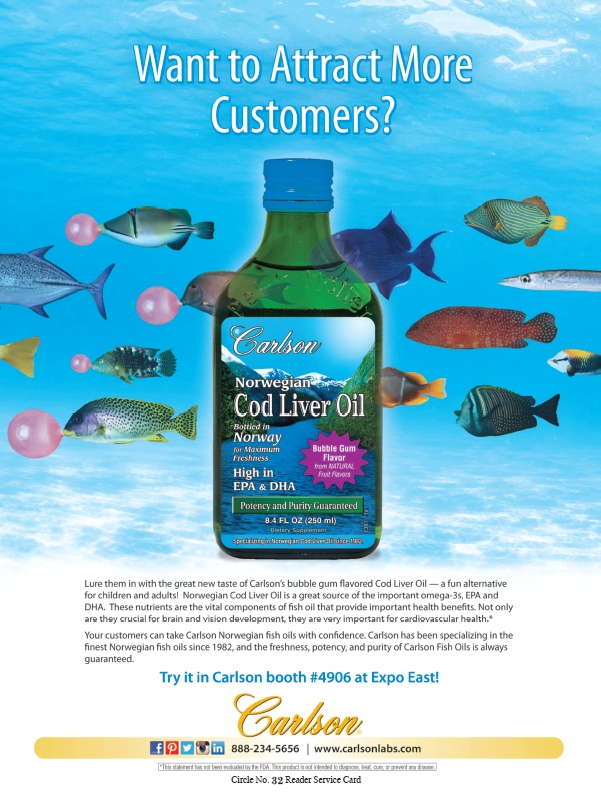 rendered possible through the use of emulsion technology. “Emulsified fish oils are ideal for kids,” says Koch, citing the example of a natural lemon zest flavored product with a smoothie-like taste and texture, which puts kids (and adults!) in mind of a dessert treat rather than a supplement. Wright backs this up by saying that the two most popular omega-3 delivery formats for kids are emulsions and gummies. “These modes of delivery have really opened up the omega-3 market to this very important demographic. Someday soon, we hope to have a gummy application for krill that will be a nice fit for this group,” she says.
rendered possible through the use of emulsion technology. “Emulsified fish oils are ideal for kids,” says Koch, citing the example of a natural lemon zest flavored product with a smoothie-like taste and texture, which puts kids (and adults!) in mind of a dessert treat rather than a supplement. Wright backs this up by saying that the two most popular omega-3 delivery formats for kids are emulsions and gummies. “These modes of delivery have really opened up the omega-3 market to this very important demographic. Someday soon, we hope to have a gummy application for krill that will be a nice fit for this group,” she says.
Some gummie products have significant amounts of sugar and artificial flavors, Parker cautions. He feels that at some point, the negatives may outweigh the positives in such products. With modern technology, naturally flavored, easy-to-chew soft gels suitable for kids are possible (more on delivery formats later).
Nonetheless, gummies have emerged as preferable to soft gels for kids. However, Hjaltason notes they are typically only capable of delivering relatively small volumes of EPA and DHA in each serving. In Nordic countries, where the cod liver oil from the spoon tradition is alive and well, kids don’t mind getting their daily dose without any flavoring, he says. But in North America, where no such cultural norm exists, gummies and other kid-friendly forms will likely remain in vogue.
It’s important, too, to recognize how critical omega-3 intake can be in early life. “Taste is certainly a factor. But so is the idea—geared toward the parents buying the supplements—that marine oils and omega-3s are critical to cognitive health and mental development,” says Myers. She suspects there’s an element of genuine concern combined with the competitive parenting mantra that says, “I want the best for my child, and I want my child to succeed, and I believe this will help.”
New research emphasizes the need for omega-3 fatty acids in childhood, according to Root. Lower blood DHA concentrations were associated with poorer reading ability and working memory, and higher oppositional behavior in UK children (2). In other words, low omega-3 levels, particularly DHA, may predict behavior and learning problems. Koch also points out that in addition to areas like attention span and intelligence, eye health and visual acuity as well as the ability to deal with stress have been linked with omega-3 levels in children.
|
FDA Qualified Claims Update
“Sadly, I am not optimistic on this one,” says Jonny Bowden, Ph.D., CNS, scientific advisor to Barlean’s, Ferndale, WA. “Behind the scenes, it’s becoming clear that the cholesterol hypothesis is in trouble, and that the statin drugs which are prescribed to reduce the risk of heart disease, are very far from a panacea,” he says. As problems mount for statins and the cholesterol theory of heart disease, he believes, a shift will take place, where statin drugs will be marketed with the claim of being “anti-inflammatory.” This may coincide with drug companies lobbying to make “inflammation” a medical condition, which might then render “anti-inflammatory” an off-limits “disease claim” once and for all in marine oil marketing, says Bowden. He thinks this type of pattern will inevitably continue, until the natural products industry stands up to FDA. But in some circles, there’s hope. “GOED, the global organization of EPA and DHA Omega-3, has been working on upgrading the FDA qualified claim for heart health,” says Baldur Hjaltason, sales director for Epax AS, Oslo, Norway. GOED has also been working on documentation to establish the link between omega-3s and blood pressure, which would represent a new claim. There is also the lack of Recommended Daily Intakes or Daily Allowances for EPA and DHA to contend with. Hjaltason says there was work going on in this area, but a lack of funds seems to have slowed things down. Whatever the future holds, there should be agreement that allowing science-based health claims for omega-3 would benefit public health, says Todd Parker, vice president of Marine Ingredients, Mt. Bethel, PA. “I believe the research is clear that increasing omega-3 consumption is as important as eating more plants, getting exercise and controlling stress,” he states. |
|
Citing the source. Most generic omega-3 products make little reference on their packaging to the source of the omega-3s they contain. In contrast, some products, especially in the natural channel, make a point of highlighting the species and often the location used as a source for the nutrients. How much does this information matter to consumers, and is the use of this information in product marketing a trend to follow?
The practice of listing the name of the source species will become more important as consumers increase their interest in the origin of their marine oil products, Hjaltason believes. However, because much of the crude marine oil being produced is made from blends of different fish species, individual species are often difficult to designate. For this reason, he thinks that oils listing specific sources will always be niche products.
An example of such a product, designed to appeal to consumers concerned with where their omega-3s come from, is omega-3 from wild Alaskan sockeye salmon, says Susan Hazels Mitmesser, Ph.D., director of nutrition research for Solgar, Leonia, NJ. She says that while most fatty, cold-water fish are good sources of omega-3, this species is one of the richest sources, and that its natural oil is among the purest of all ocean fish. “The nutritional notoriety of a marine oil source as well as the manner in which it is harvested often play important roles in consumers’ overall purchasing decisions,” Hazels Mitmesser says. Wright adds that some consumers may gravitate toward krill oil because of its purity and sustainability profile.
Myers agrees that many consumers are interested in this information, and she says her company touts that its product is made from wild-farmed Atlantic salmon. This is to distinguish it from the typical fish farm and to reassure customers that fish stores are not being depleted.
The salmon in this case are contained in ocean fjords in Norway and Scotland. “These deep-water, narrow inlets are protected with marine-friendly nets that both protect the salmon and prevent them from leaving the fjord, but allow the advantages of ocean life,” Myers says. These advantages included fresh, clean water and natural diets, but without the dangers of predation. While this population of salmon is managed, they are in fact “wild farmed,” she says, meaning they are not kept in shallow, artificial “fish farms” miles inland in sometimes unsanitary conditions. No part of the salmon is wasted in this supply chain, she adds: the head tissue, rich in phospholipids, is used for supplements, and the rest of the body is filleted for food.
One only has to look at the backlash against genetically modified foods to see that many people are concerned about the source of items they ingest, Parker says, and in the case of marine oils, the sustainability factor is also important to many consumers.
Indeed, consumers are smarter and savvier than ever thanks to the ease of access to information today, Koch says. For this market, it means a strong interest in not only what type of marine life is used for a supplement, but how and where it’s sourced. Many consumers may look for reputable third-party product verifications, like those from International Fish Oil Standards (IFOS) and the Marine Stewardship Council (MSC). “The purest, freshest, highest quality fish come only from the world’s most pristine waters,” Koch says.
Part of the evolution of this category has been the introduction of new and more exotic marine sources of omega-3s. There may not be much more left to do in this regard, though. “I’ve definitely seen some exotic (i.e., strange) sources emerging, which probably has a lot to do with the overall importance and appeal of the omega-3 category,” says Wright, but she adds that she doesn’t see these newcomers gaining much market share anytime soon.
Still, Parker feels that we would be remiss not to mention squid, perhaps a less heralded option but a viable one nonetheless. There is a huge squid biomass in the oceans, and much of the fishing is done with hook lines, meaning there is little by catch of other species. Squid oil is high in DHA content, and omega-3s from squid are sourced from human-grade food material, he explains. “Squid is a very important story as it provides an excellent example of how we can source omega-3 from the raw material left over from seafood production,” Parker says.
Some companies may market products from “new” marine 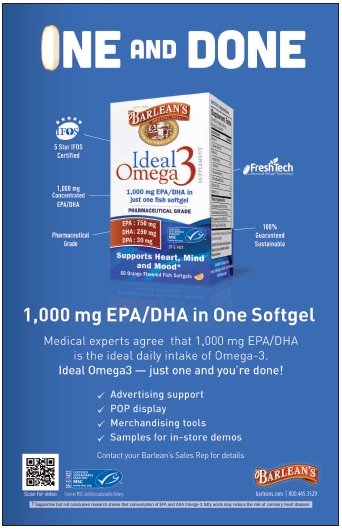 sources to gain a competitive edge, Marshall feels. “I suspect we’ll continue to see new marine sources popping up. It’s critical that these new products have the research to back up the claims that are made about them,” she says.
sources to gain a competitive edge, Marshall feels. “I suspect we’ll continue to see new marine sources popping up. It’s critical that these new products have the research to back up the claims that are made about them,” she says.
It is also important to track the potential movement away from marine oils altogether. Hjaltason says that with several pharmaceutical products coming to market that contain EPA and DHA from fish oil, demand is set to increase like never before. This is occurring while worldwide production remains somewhat stagnant. Although the majority of crude fish oil is still just used for salmon feed, increased demand for crude fish oil for human consumption may lead supplement manufacturers in the direction of algae and algal oils.
Delivering the goods. While manufacturers may have gained some mastery over areas like concentration, delivery formats continue to evolve in the search for enhanced bioavailability, health benefits and convenience.
There has been something of an explosion in these new delivery forms, enabling consumers to get their omega-3s in ways besides basic oils or soft gels, Hjaltason explains. “This includes emulsions, nano-microencapsulated powder and liposomes,” he says.
Eyal and Attias describe their company’s take on a “complete” omega-3 product, one that preserves the nutrient profile naturally found in fish, including fish phospholipids. A cold extraction process followed by the MSO preparation technology also “enables us to preserve the natural omega-3 form occurring in fish,” they say. The wild fish lipid extract that results contains omega-3 fatty acids bound to phospholipids and to triglycerides.
Phospholipid-bound omega-3s, according to Wright, efficiently enter human cells, thereby helping to keep the heart, brain and joints healthy. She says that omega-3s in this format also mix well with stomach contents. “In the case of krill, being phospholipid-based offers many formulation advantages, particularly for consumers who want smaller, more effective pills that are easy on digestion,” Wright says. She adds that in her company’s proprietary krill ingredient, the natural presence of the antioxidant astaxanthin helps keep the rest of the nutrients fresh and stable.
|
Select Marine Products
Listed below are products and ingredients available from companies interviewed in this feature. |
|
The EPA and DHA in an ingredient from Massrieh’s company are also attached to and carried by phospholipids. “Phospholipids are a major component of all biological membranes and contribute to the membrane’s permeability and fluidity,” he says. Phospholipids are efficient delivery systems because they are amphipathic (both lipid soluble and water soluble), Massrieh says, adding that this also means different technologies must be employed to keep the omega-3s homogeneously suspended in functional foods, beverage products especially.
The omega-3 extraction process for an ingredient from Myers’s company uses only water and enzymes. This process also derives phospholipids and bioactive peptides from the head of the salmon. These peptides are a unique feature, she says, and the array of peptides provided helps fight free radicals and support immune, digestive, joint and cardiovascular health.
Emulsion technology, discussed in the context of getting kids to take their omegas, also provides absorption efficiency, says Koch. His company’s proprietary technology reduces the size of fish oil molecules, allowing the oil to pass through the intestinal wall and enter the bloodstream more efficiently.
Hazels Mitmesser describes the use of mini soft gels that can be both chewed and swallowed. This development allows consumers to choose between two delivery formats in one product, based upon preference.
Some of these technologies will be best applied to the functional food market, Hjaltason believes, but regardless, the result may be an increase in the total intake of marine based omega-3 fatty acids in the population. On that count, Marshall says, “It is important to keep pushing the envelope, exploring and developing new formulations and delivery systems so that everyone has access to this essential nutrition.”
Science: New and Noteworthy
Before we get to all the positive news in the world of omega-3 science, let’s address a recent publication that caused a spell of negative attention to befall the category. The conclusion that researchers drew, and the media repeated, from a study published in July 2013 in the Journal of the National Cancer Institute, is that high levels of omega-3 fatty acids, particularly DHA, were associated with heightened risks of prostate cancer in men.
WholeFoods science editor Richard Passwater, Ph.D., provided his views on the study, which examined data from the Prostate Cancer Prevention Trial, at the time the news was circulating and in this month’s Vitamin Connection column (see page 53). Passwater and fish oil expert Jørn Dyerberg, M.D., Dr. Med. Sc., argue that the differences between the omega-3 levels in the cancer groups and the control groups were so small as to be statistically irrelevant. They also point to the quantity of research that indicates that fish and fish oil are, if anything, protective against prostate and other cancers.
Industry trade associations and advocacy groups were also at the ready with critical responses to the study. “The numerous benefits of omega-3 fatty acids from foods (like salmon and sardines) and dietary supplements are well-established for men and women in all stages of life—and this new study does not change those recommendations about the importance of this nutrient,” said Duffy MacKay, N.D., vice president of scientific and regulatory affairs for the Council for Responsible Nutrition in a statement.
The Natural Products Association also released a statement, including comments from senior vice president of scientific and regulatory affairs, Cara Welch, Ph.D., which read in part: “The authors’ jump to blaming supplements for these results is irresponsible, at best, when the study didn’t include any information about how the omega-3 intake was achieved. Consumers should continue to feel comfortable taking their omega-3 supplements.”
Jonny Bowden, Ph.D., CNS, scientific advisor to Barlean’s, also felt that this study needed to be addressed, particularly the style of media reporting that followed its publication. “People continue to be stunned by the fact that no fish oil supplements were used in the study! Every reputable researcher—including prostate cancer experts from Harvard—have dismissed this study and have condemned the terrible, biased reporting on it by the mainstream media,” he says.
Regardless of any future studies that suggest specific risks, the consensus will likely remain that the overwhelming bulk of data and research point to various health benefits from omega-3 intake. The following add to that mountain of research and insight, including some studies that further our understanding of how omega-3s improve health.
One insight Eyal and Attias emphasize is that the fatty acid ratios present in red blood cells (RBCs) reflect long-term intake and absorption of omega-3s. Absorption into RBC membranes parallels absorption into target organs including the heart, brain and liver. This is why the omega-3 index (the percentage of EPA and DHA out of the total fatty acids in RBCs) is a crucial risk factor for cardiovascular disease, and one that consumers are increasingly having checked as part of their healthcare.
Cognitive health and mood represent an emerging area of omega-3 science, at least when compared with the well-established cardiovascular benefits of fish oil (see the sidebar “FDA Qualified Claims Update”). In April 2013, Wright says her company published a study in Lipids in Health and Disease evaluating the benefits of krill oil for cognitive function and mood. The effects of krill oil were compared with those of the pharmaceutical antidepressant imipramine in rats after seven weeks, and krill oil stacked up well, improving learning and working memory and displaying antidepressant-like effects (3).
Another study that overlaps the realms of cognitive and cardiovascular health is cited by both Koch and Trisha Sugarek MacDonald, B.S., M.S., director of R&D/national educator for Bluebonnet Nutrition Corp., Sugar Land, TX. It showed that EPA and DHA may blunt the negative cardiovascular effects caused by mental stress. Participants with normal blood pressure were given a five-minute mental stress protocol as a baseline, then were given either a placebo or 1,600 mg of EPA and 1,100 mg of DHA daily for eight weeks. When the test was repeated, the fish oil group did not have elevated heart rates like the control group (4). Sugarek MacDonald calls this “an added piece to the story of why fish oil is beneficial for heart physiology.”
Marshall explains one reason why the link between omega-3s and brain health is currently of great interest. “With the oldest Baby Boomers now in their mid-60s, there is ample interest in omega-3s as they relate to memory retention. Research also continues to indicate that supplementation with marine oils can play a neuroprotective role with regard to traumatic brain injury,” she says. Michael Lewis, M.D., who founded the Brain Health Education and Research Institute, has done important research on brain injuries and omega-3s, Marshall says, adding, “He has also participated in research linking suicide deaths of active-duty U.S. military to low serum DHA.”
In adolescents, the growth of new nerve cells in the brain is rapid, according to Root. New research from San Pablo University in Spain, which she says was presented at The Endocrine Society’s 95th Annual Meeting in San Francisco, links the junk food diets common in teens to problems with neurogenesis, or nerve cell generation. “But, fish oils may come to the rescue,” Root says. A review of 185 studies by a team at the University of Liverpool found that despite bad dietary habits, those that consume enough omega-3s can protect areas like learning and memory (5). “Fish oils appear to inhibit the detrimental effects of some of the impaired cognitive processes triggered in the brain by high-fat diets,” Root says.
Shifting from the brain to the metabolism, Sugarek MacDonald cites a meta-analysis that suggests omega-3s may help control blood glucose, an important factor for diabetics. A review of 14 clinical trials found individuals taking fish oil supplements had increased levels of adiponectin (6). “Adiponectin is an important hormone that has beneficial effects on metabolic processes, such as glucose regulation and the modulation of inflammation,” she says.
In a similar vein, Wright points to a study on the effects of krill powder on obese patients. Eleven obese men underwent a 24-week trial with the supplement. Researchers then assessed blood lipids, endocannabinoids and other parameters. Triglyceride levels were reduced by 21%, and three different endocannabinoids, which are dysfunctional in obese individuals, were positively impacted. Researchers also found decreased waist-to-hip and visceral fat-to-skeletal muscle mass ratios.
Recent science is also unveiling protective effects of omega-3s against serious diseases. “For example, a recent study out of the United Kingdom indicates that omega-3s may reduce the risk of skin cancer. This is obviously helpful information for people who spend time outdoors,” says Parker (7). Also, a recent meta-analysis in the British Medical Journal found that higher omega-3 consumption was correlated with a lower risk of breast cancer (8). “This is an important study because it integrated data from 26 publications, over 900,000 patients and 21 independent prospective cohort studies,” says Bowden.
Omega-3s are being implicated in a positive way with the health of the skeletal system, including one recent finding involving postmenopausal women (9). Sugarek MacDonald says, “In this study, the researchers analyzed blood samples in women, with and without a history of having a broken hip, and it was found that higher values of serum omega-3s were associated with a lower likelihood of having a fractured hip.” Though the mechanism of action was not defined, she says it is assumed that inflammation may contribute to bone resorption, the body’s way of breaking down bone, since omega-3s are thought to reduce inflammation.
A link has been found between omega-3 supplementation and the protection of arteries from damage caused by smoking, according to Tom Gilhooly, M.D., scientific advisor to Barlean’s. That damage normally occurs not through direct contact as with lung damage, he says, but through an increase in inflammation at the cellular level. This recent study from Greece looked at two measures of arterial stiffness, flow mediated dilation (FMD) and pulse wave velocity (PWV). “Both of these factors were significantly reduced by the consumption of 2 g of omega-3 supplements over a relatively short 12-week period,” Gilhooly says (10). He goes on to say, “While we would always advocate stopping smoking, for those who are not ready or able to do so, it is never too late or too early to improve the diet.”
All of these results are great, but to feel comfortable, scientists like to understand in more biological detail why these benefits occur. Inroads are being made in this area, too. “One of the most exciting new emerging sciences in the field of marine-based omega-3 fatty acids is its role in the aging process,” Hjaltason says. Much of this is based on the pioneering work done by others on telomeres, which he explains are stretches of DNA that cap the ends of chromosomes, keeping cells in the human body from aging too soon.
One recently published study evaluated the fatty acid ratios typical in the standard U.S. diet in comparison with a more omega-3 heavy diet (11). “The results were striking. Telomere length increased in the omega-3 group while the group given the typical U.S. diet showed reduction in telomeres length. Although further research is needed, it is exciting to see how marine-based omega-3 fatty acid might affect the aging process and perhaps longevity and quality of life,” Hjaltason says.
A focus on the interactions between omega-3s and gene expression has been prevalent in recent years, he explains. These mechanisms are complex, but it is thought that the modulation of specific genes by omega-3s is responsible for many of the effects of EPA and DHA. Also in recent years, scientists have developed techniques to find defective genes in humans, which increase the risks of various diseases later in life. Hjaltason believes this opens up the possibility of tailoring supplements to help individuals reduce those risks.
Parker says this study of how nutrition and genes interact is called nutragenomics. He says research shows ingesting omega-3s can “quiet” over 900 genes related to inflammation. “We will soon know if the health benefits of omega-3 are more related to the impact on genetic expression than to the mechanistic benefits, such as increasing the cellular content of omega-3 at the expense of pro-inflammatory arachidonic acid,” Parker says.
These intricacies of inflammation are under special investigation, in turn shedding more light on the benefits of fish oil. Root cites findings that shed light on how DHA dampens inflammation in the brain and throughout the body (12). “Macrophages use DHA to form novel compounds called maresins that act as switches, turning off inflammation via a process dubbed resolution,” she says.
A synthetic derivative of DHA, called neuroprotectin D1, has been studied for its role in relieving chronic neuropathic pain (13). Root says the science of docosanoids (the name for these compounds derived from DHA) is compelling, and will likely lead to new DHA-based drugs. But, consumers need not wait for those drugs to arrive. She says, “Having good stores of DHA in cell membranes enables the body to form the docosanoids as needed to relieve pain, resolve inflammation and support nerve growth.” WF
References
1. “Use of CoQ10, Digestive Enzymes, Probiotics and B Vitamins on the Rise According to ConsumerLab.com Survey,” Consumerlab.com, Feb. 1, 2013, http://www.consumerlab.com/news/highlights_vitamin_supplements_survey/01_31_2013, accessed July 31, 2013.
2. P. Montgomery, et al., “Low Blood Long Chain Omega-3 Fatty Acids in UK Children Are Associated with Poor Cognitive Performance and Behavior: A Cross-Sectional Analysis from the DOLAB Study,” PLoS One. 8(6), e66697 (2013).
3. K. Wibrand, et al., “Enhanced Cognitive Function and Antidepressant-like Effects After Krill Oil Supplementation in Rats,” Lipids Health Dis. 12:6, doi: 10.1186/1476-511X-12-6 (2013).
4. J.R. Carter, et al., “Fish Oil and Neurovascular Reactivity to Mental Stress in Humans,” Am. J. Physiol. Regul. Integr. Comp. Physiol. 304(7), R523-30 (2013).
5. M.A. Yon, “Relationships Between Dietary Macronutrients and Adult Neurogenesis in the Regulation of Energy Metabolism,” Br. J. Nutr. 109(9), 1573-89 (2013).
6. J.H. Wu, “Effect of Fish Oil on Circulating Adiponectin: A Systematic Review and Meta-Analysis of Randomized Controlled Trials,” J. Clin. Endocrinol. Metab. 98(6), 2451-9 (2013).
7. S.M. Pilkington, et al., “Randomized Controlled Trial of Oral Omega-3 PUFA in Solar-simulated Radiation-induced Suppression of Human Cutaneous Immune Responses,” Am. J. Clin. Nutr. 97(3), 646-52 (2013).
8. J. Zheng, et al., “Intake of Fish and Marine n-3 Polyunsaturated Fatty Acids and Risk of Breast Cancer: Meta-Analysis of Data from 21 Independent Prospective Cohort Studies,” BMJ 346, f3706 (2013).
9. T.S. Orchard, et al., “The Association of Red Blood Cell n-3 and n-6 Fatty Acids with Bone Mineral Density and Hip Fracture Risk in the Women’s Health Initiative,” J. Bone. Miner. Res. 28(3), 505-15 (2013).
10. G. Siasos, et al., “Effects of Omega-3 Fatty Acids on Endothelial Function, Arterial Wall Properties, Inflammatory and Fibrinolytic Status in Smokers: A Cross Over Study,” Int. J. Cardiol. 166(2), 340-6 (2013).
11. J.K. Kiecolt-Glaser, et al., “Omega-3 Fatty Acids, Oxidative Stress, and Leukocyte Telomere Length: A Randomized Controlled Trial,” Brain. Behav. Immun. 28, 16-24 (2013).
12. J. Dalli, et al., “The Novel 13S,14S-epoxy-maresin is Converted by Human Macrophages to Maresin 1 (MaR1), Inhibits Leukotriene A4 Hydrolase (LTA4H), and Shifts Macrophage Phenotype,” FASEB J. 27(7), 2573-83 (2013).
13. Z. Xu, et al., “Neuroprotectin/Protectin D1 Protects Neuropathic Pain in Mice After Nerve Trauma,” Ann. Neurol. Epub ahead of print (2013).
Published in WholeFoods Magazine, September 2013


 The single qualified health claim that the U.S. Food and Drug Administration (FDA) recognizes for omega-3s has remained all by its lonesome since its introduction in 2004. It reads: “Supportive but not conclusive research shows that consumption of EPA and DHA omega-3 fatty acids may reduce the risk of coronary heart disease.” But as we know, there are other health benefits from omega-3s. And when can we deem that heart health research conclusive, FDA?
The single qualified health claim that the U.S. Food and Drug Administration (FDA) recognizes for omega-3s has remained all by its lonesome since its introduction in 2004. It reads: “Supportive but not conclusive research shows that consumption of EPA and DHA omega-3 fatty acids may reduce the risk of coronary heart disease.” But as we know, there are other health benefits from omega-3s. And when can we deem that heart health research conclusive, FDA?